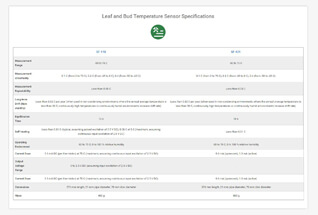Monitor Radiation Frost Events
On calm, clear nights, the surface temperature of leaves can drop well below air temperature due to a net loss of longwave radiation from the leaf into the air. A radiation frost occurs when frost forms at the surface of the leaf before the air temperature reaches freezing (0 C). Under cloudy and/or windy conditions, radiation frost events do not occur. The Apogee radiation frost detector contains a high accuracy thermistor mounted in a durable housing. The thermistor is designed to mimic a leaf, providing estimates of leaf temperatures and a direct means of monitoring radiation frost events.
Wide Range, Accurate Measurements
Thermistor accuracy is ± 0.1 C across a range of 0 to 70 C, providing accurate measurements at temperatures near zero where frost damage is likely to occur.
Typical Applications
Applications include leaf temperature estimates in cropped fields, orchards, and vineyards. These leaf temperatures can then be used to alert growers of the potential for frost damage to crops.
Output Options
Analog and digital output options are available. Analog version is an un-amplified voltage output. Digital version is SDI-12 communication protocol.
Above: Leaf temperature approximations measured with an Apogee SF-110 compared to air temperature (top panel) and wind speed (bottom panel) on the evening of April 28, 2012. Leaf temperatures were below air temperature after 8 P.M. and reached freezing 6 hours before the air temperature.
Mounting
The body contains two holes on the bottom that allow the product to be zip-tied or mounted to a mast, pipe, stick, branch, etc. Additionally, Apogee also sells the AM-260 mounting bracket for long-term mounting of the sensor. This allows the radiation frost detector to be oriented at varying angles to satisfy all applications.
Warranty and Support
All Apogee products are backed by an industry-leading four year warranty and outstanding customer support.




